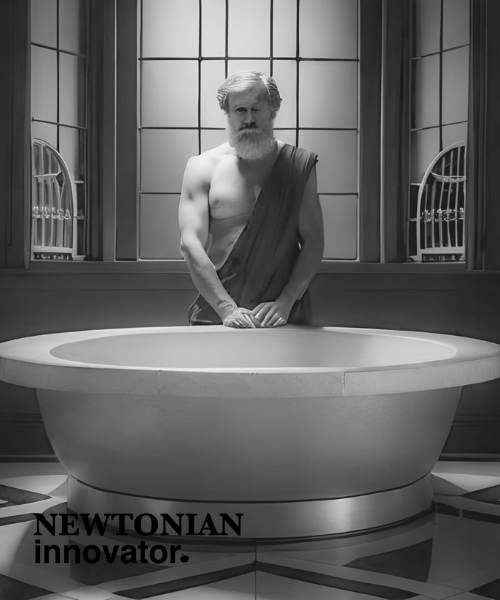Archimedes’ legendary thought experiment used the imaginative idea of water displacement to devise an innovative way to determine the density and composition of an irregular object non-destructively. It was one of the earliest examples of abstract theoretical reasoning applied to a practical problem.
Archimedes was born around 287 BC in the seaport city of Syracuse on the island of Sicily. He was the son of an astronomer named Phidias. In his youth, Archimedes studied in Alexandria, Egypt which was a major center of scholarship and science at the time. After completing his studies, he returned to Syracuse where he spent most of his life focused on groundbreaking research in mathematics, physics, engineering and astronomy. Many details of his personal life are unknown, but anecdotes describe him as preoccupied with his work to the point that he often forgot to eat and bathe. Though he despised politics, he designed ingenious war machines to defend his hometown during the Second Punic War when Syracuse was attacked by Roman forces. Archimedes was killed around 212 BC by a Roman soldier, despite orders to spare the great scholar’s life. He is remembered as one of the most brilliant mathematicians and inventors from ancient times. Many of his discoveries and theories in geometry, mechanics, hydraulics, and methods anticipating aspects of calculus, formed the foundation for modern science and technology.

Archimedes’ brilliant thought experiment about water displacement was more than just a flash of genius, it led to concrete advances in scientific understanding. His imaginary scenario laid the groundwork for mathematical formulas that could precisely calculate volume, density, and buoyancy.
The realization that the amount of water displaced would equal the volume of an irregular object allowed Archimedes to devise a repeatable, measurable technique for determining volume. This introduced significant precision into an area previously limited to estimates and rules of thumb.
According to legend, the king of Syracuse, The tyrant King Hieron II had a golden crown made, but he suspected that the goldsmith might have cheated him by substituting some of the gold with silver. The king asked Archimedes to determine whether the crown was pure gold without melting or damaging it. The potential to weigh objects of known volume and compare them to the crown also yielded new wisdom into density as a measurable property. Archimedes’ approach thus enabled numerical analysis rather than pure guesswork when assessing the composition of objects.
Moreover, the technique of visualizing a conceptual scenario in order to gain knowledge became a cornerstone of scientific reasoning. While thought experiments are imaginary, they subject hypothetical scenarios to the rigors of logic in pursuit of new truths. By imagining the crown’s displacement and deducing mathematically sound conclusions, Archimedes demonstrated the power of abstract and creative thinking to solve tangible problems. This systematic theoretical analysis influenced generations of philosophers and scientists. The “Eureka” moment has come to symbolize flashes of genius gained through conceptual contemplation and imagination untethered from the limits of physical reality.
Normally, determining the composition of a compound involves statistical analysis – melting down the metal and precisely measuring the densities and proportions of its basic elements. But destroying the elaborate crown was not an option. Archimedes realized he needed an alternative, indirect approach. While pondering the problem as he relaxed in a bathhouse, he noticed that the level of the bathwater rose as his body displaced the water. Suddenly, he had a vision, he could submerge the crown and measure the amount of water displaced.
In this flash of brilliance, Archimedes envisioned an experiment. First, he would lower the crown into a vessel full to the brim with water, and measure the overflow to indicate the volume of the crown. Next, he would fill the vessel with pure gold, finely divided into the same weight as the crown. If the gold displaced less water than the crown, the crown’s volume would be greater, definitively proving it was not pure gold, but had been tainted with the less dense silver.
Archimedes leapt from the bath and ran home naked, repeatedly shouting “Eureka!” meaning “I have found it!” in his Greek language. After performing the experiment and confirming the crown displaced more water than an equal weight of pure gold, Archimedes could conclusively report back to the king that the crown was not made purely of gold. The thought experiment based on water displacement had allowed him to determine the crown’s composition without damaging it in any way.

Archimedes’ understanding about displacement formed a basis for the quantitative study of density and buoyancy. By showing that submerged objects displace an amount of water equal to their volume, he devised a reproducible method to measure the volume of irregularly shaped objects. This introduced a new level of mathematical precision into the determination of volume beyond approximations based on shapes.
His imaginary scenario about comparing the crown to pure gold also paved the way for density to be treated as an assessable property rather than a conditional trait. Weighing the water displaced by equal weights of different materials allowed their densities to be expressed numerically and analyzed mathematically. Archimedes’ thought experiment invented a technique for assessing density indirectly by clever exploitation of displacement and weight.
Archimedes’ reliance on imagined scenarios as a problem-solving technique influenced the development of theoretical science. Visualizing hypothetical situations rigorously and deducing their consequences is the essence of thought experiments. Archimedes exemplified how abstract reasoning could yield new knowledge about the concrete physical world. His groundbreaking use of imaginary set-ups to uncover truths about reality helped validate thought experiments as sources of tangible insight.
Archimedes’ work emphasizes the power of thought experiments as springboards for innovation. By mentally simulating scenarios, he gained knowledge ranging from mathematical proofs to physical laws. Scientists today increasingly value conceptual reasoning and computational modeling as complements to experimental work. Archimedes provides an early example of how virtual prototyping and manipulation of ideas can effectively simulate reality. His deductive, hypothetical style demonstrates the vital role of imagination in forming theories that advance testable science. Abstract exploration empowers researchers to investigate beyond the feasible to thereby expand the boundaries of knowledge.
The interdisciplinary nature of Archimedes’ contributions also holds lessons for modern scientists seeking to tackle complex questions. He fluidly connected mathematics to engineering, applying abstract concepts to answer practical problems. Similarly, breakthroughs today often emerge at intersections of fields, as cross-pollination of ideas drives creativity. Archimedes’ lifelong dedication to following his research interests models the passionate pursuit of knowledge for its own sake. By taking inspiration from Archimedes’ innovative mindset, scientists can better leverage thought experiments and intellectual adventures to push the frontiers of possibility.






